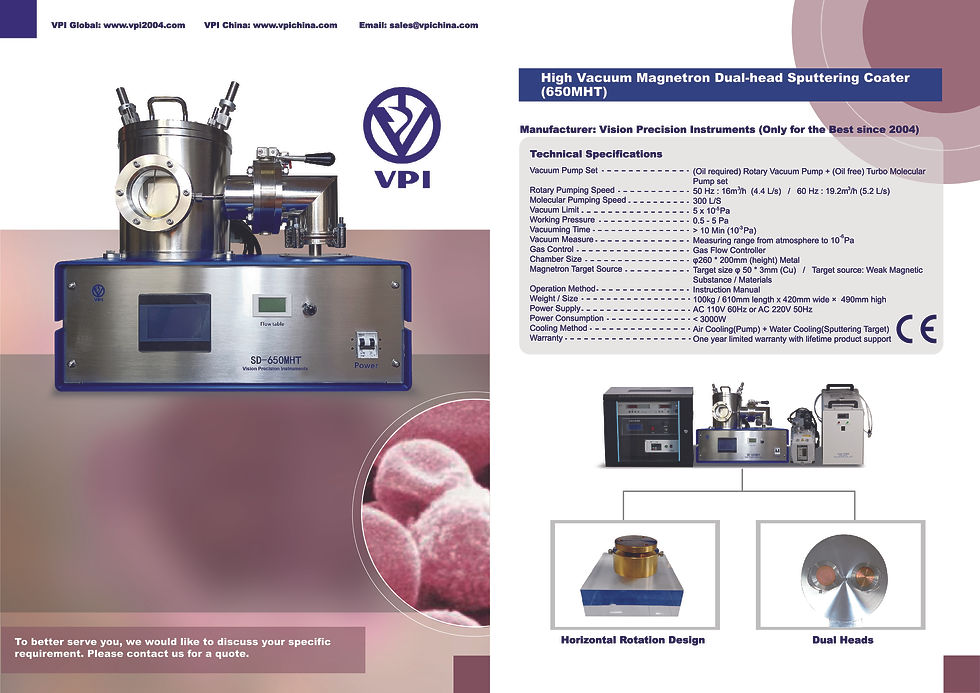
Tingting
Jun 17, 2023
Surface engineering plays a crucial role in various industries, including automotive, aerospace, tooling, and biomedical applications. It involves modifying the surface properties of materials to enhance their performance, durability, and resistance to wear, corrosion, and other detrimental factors. The High Vacuum Magnetron Dual-Head Sputtering Coater offers exceptional capabilities for surface engineering applications, making it a valuable tool for researchers and manufacturers in this field.
Surface Engineering Application for High Vacuum Magnetron Dual-Head Sputtering Coater
Surface engineering plays a crucial role in various industries, including automotive, aerospace, tooling, and biomedical applications. It involves modifying the surface properties of materials to enhance their performance, durability, and resistance to wear, corrosion, and other detrimental factors. The High Vacuum Magnetron Dual-Head Sputtering Coater offers exceptional capabilities for surface engineering applications, making it a valuable tool for researchers and manufacturers in this field.
One of the key advantages of the dual-head sputtering coater for surface engineering is its ability to deposit a wide range of materials, including metals, alloys, ceramics, and semiconductors. This versatility allows for the creation of coatings with tailored properties to meet specific surface engineering requirements. For example, the deposition of hard coatings, such as nitrides or carbides, can significantly enhance the wear resistance and durability of cutting tools, extending their lifespan and improving machining performance.
The precise thickness control offered by the coater is another crucial factor in surface engineering applications. Coating thickness plays a vital role in determining the desired properties, such as hardness, adhesion, and corrosion resistance. With the ability to deposit coatings with nanometer-scale accuracy, researchers can optimize the coating thickness to achieve the desired performance characteristics.
The high vacuum environment provided by the coater is also advantageous for surface engineering applications. It ensures the absence of impurities and contaminants during the deposition process, leading to high-quality coatings with improved adhesion and reduced defects. This is particularly important for applications where coating integrity and reliability are critical, such as corrosion protection coatings in harsh environments.
Additionally, the dual-head configuration of the coater enables uniform coating deposition across large substrate areas. This uniformity ensures consistent surface properties and coating thickness, which is vital for achieving reliable and predictable performance. Whether coating complex-shaped components or large surfaces, the dual-head sputtering coater ensures the same high-quality results throughout.
Surface engineering applications utilizing the High Vacuum Magnetron Dual-Head Sputtering Coater extend beyond wear and corrosion resistance. It can also be employed to create functional coatings with specific optical, electrical, or thermal properties. For example, the deposition of transparent conductive oxide coatings on glass or flexible substrates enables the production of touchscreens, displays, and solar cells.
In conclusion, the High Vacuum Magnetron Dual-Head Sputtering Coater is a versatile and powerful tool for surface engineering applications. Its ability to deposit a wide range of materials, precise thickness control, high vacuum environment, and uniform coating deposition make it highly suitable for enhancing the properties of materials in various industries. By utilizing this advanced technology, researchers and manufacturers can develop coatings that improve the performance, durability, and reliability of components and surfaces, leading to enhanced product quality and extended lifespan.